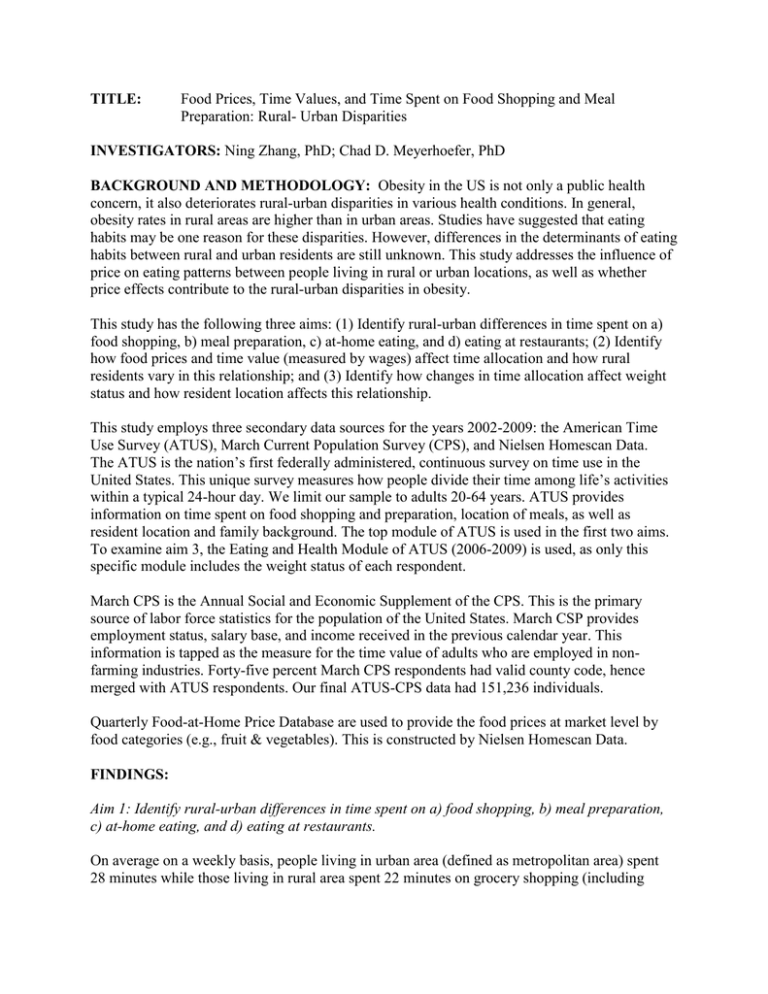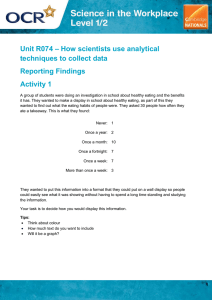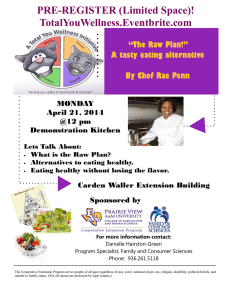TITLE: Food Prices, Time Values, and Time Spent on Food Shopping... Preparation: Rural- Urban Disparities
advertisement

TITLE: Food Prices, Time Values, and Time Spent on Food Shopping and Meal Preparation: Rural- Urban Disparities INVESTIGATORS: Ning Zhang, PhD; Chad D. Meyerhoefer, PhD BACKGROUND AND METHODOLOGY: Obesity in the US is not only a public health concern, it also deteriorates rural-urban disparities in various health conditions. In general, obesity rates in rural areas are higher than in urban areas. Studies have suggested that eating habits may be one reason for these disparities. However, differences in the determinants of eating habits between rural and urban residents are still unknown. This study addresses the influence of price on eating patterns between people living in rural or urban locations, as well as whether price effects contribute to the rural-urban disparities in obesity. This study has the following three aims: (1) Identify rural-urban differences in time spent on a) food shopping, b) meal preparation, c) at-home eating, and d) eating at restaurants; (2) Identify how food prices and time value (measured by wages) affect time allocation and how rural residents vary in this relationship; and (3) Identify how changes in time allocation affect weight status and how resident location affects this relationship. This study employs three secondary data sources for the years 2002-2009: the American Time Use Survey (ATUS), March Current Population Survey (CPS), and Nielsen Homescan Data. The ATUS is the nation’s first federally administered, continuous survey on time use in the United States. This unique survey measures how people divide their time among life’s activities within a typical 24-hour day. We limit our sample to adults 20-64 years. ATUS provides information on time spent on food shopping and preparation, location of meals, as well as resident location and family background. The top module of ATUS is used in the first two aims. To examine aim 3, the Eating and Health Module of ATUS (2006-2009) is used, as only this specific module includes the weight status of each respondent. March CPS is the Annual Social and Economic Supplement of the CPS. This is the primary source of labor force statistics for the population of the United States. March CSP provides employment status, salary base, and income received in the previous calendar year. This information is tapped as the measure for the time value of adults who are employed in nonfarming industries. Forty-five percent March CPS respondents had valid county code, hence merged with ATUS respondents. Our final ATUS-CPS data had 151,236 individuals. Quarterly Food-at-Home Price Database are used to provide the food prices at market level by food categories (e.g., fruit & vegetables). This is constructed by Nielsen Homescan Data. FINDINGS: Aim 1: Identify rural-urban differences in time spent on a) food shopping, b) meal preparation, c) at-home eating, and d) eating at restaurants. On average on a weekly basis, people living in urban area (defined as metropolitan area) spent 28 minutes while those living in rural area spent 22 minutes on grocery shopping (including travel time). Urban dwellers spent 34 minutes while rural residents spent 38 minutes on food preparation. The differences in these two measures were persistent over time in the study period 2002-2009, even considering the economic recession in 2008. Each week, people living in urban areas spent 50 minutes on eating at home and 17 minutes eating out in a restaurant whereas those living in rural area spent 51 minutes eating at home and 13 minutes eating out. It is not surprising that people increased their time eating at home, and reducing their time eating out in both areas between 2007 and 2009. Analysis also shows that the differences in eating out in a restaurant between people living in urban and rural areas were larger in 2009 than in 2002. These results supported our hypothesis that there existed differences in food related activities between people living in rural and urban areas. A manuscript based on these preliminary results has been submitted to The Journal of Rural Health (revise and resubmit). Aim 2: Identify the relationship between food prices and individual time values with time spent on food shopping, meal preparation, at-home and away-from-home eating. Prices of grains, fruit, vegetable, meat and dairy were separately investigated. State average wage for a specific industry were used to measure the individual time values. Significant results have been found particularly in time spent on eating out in a restaurant. Specifically, a 10-cent higher in grains or dairy would result in 11 less minutes (weekly) eating out for rural residents, compared to their urban counterparts. A 10-cent higher in vegetable prices were translated into almost 7 minutes less in eating out for those living in rural areas. Results remained significant if the rural area indicator interacted with these three prices, but lost all significance when the rural indictor interacted with salary. A manuscript with an emphasis on the prices, salary and economic recession was submitted to Journal of Health Economics (under review). Aim 3: Identify how changes in food shopping, meal preparation, and at-home and away-fromhome eating affect weight status. Results found that a 4-minute difference in eating out in a restaurant weekly was associated with 1.9 body mass index (BMI, defined as body weight divided by square of body height). This result increased to 3.3 BMI if salary and rural indicator were interacted. However, these changes in BMI are not enough to change a weight category for a person. More analyses are under going to see if this is the best result. The plan is to write a manuscript based on these results. The target journal is Journal of Biology, Agriculture and Healthcare. CONTACT INFORMATION: Ning Zhang, PhD Department of Health Promotion and Policy, School of Public Health and Health Sciences, University of Massachusetts Amherst 715 N. Pleasant Street, Arnold Building #324, Amherst, Massachusetts, 01003 Tel: 413-545-1801 E-mail: ningzhang@schoolph.umass.edu





